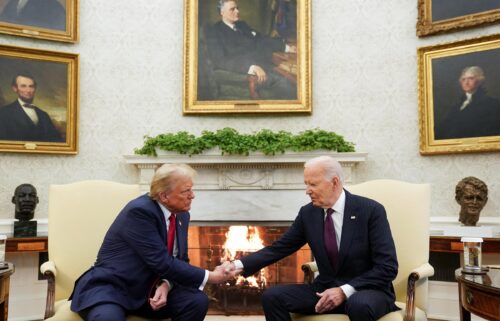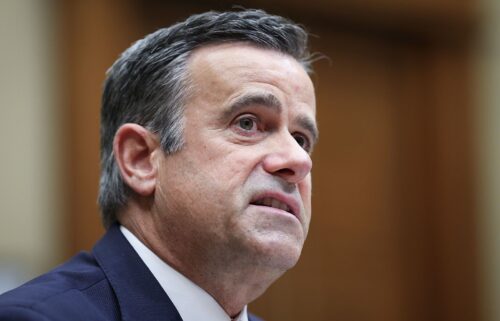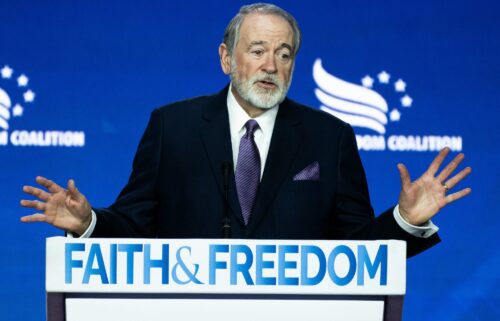5 significant bills and 5 executive orders Biden signed in his first year — and his 5 biggest priorities for 2022

By Maegan Vazquez, Kate Sullivan and Betsy Klein, CNN
President Joe Biden took the oath of office a year ago with the country facing challenges not seen in generations.
On top of a once-in-a-century pandemic, the new President inherited an economy that had crumbled as Covid-19 cases rose and a nation so divided that his predecessors supporters had stormed the US Capitol two weeks prior in a bid to stop his ascent. Still, expectations for Biden were sky high among Democrats after Jon Ossoff and the Rev. Raphael Warnock won run-off elections in Georgia to become the Peach State’s senators and flip the chamber to the Democrats, giving the Democrats control of Congress by the narrowest of margins.
Over the last year, Biden managed to get some of his top priorities passed through Congress but remains stymied on others, leaving him with less than a year to work with Democrats to pass his legislative agenda before the next Congress is sworn-in following the 2022 midterm elections. He also used his executive branch powers to sign 77 executive orders in his first year in office, outpacing his predecessors former President Donald Trump, who signed 58 executive orders in the same time; former President Barack Obama, who signed 41; and former President George W. Bush, who signed 56, according to data from the Federal Register.
Here are the top five bills Biden signed into law this year, his top five executive orders and the top five things he will prioritize in 2022.
Five marquee laws Biden signed in his first year
1. The American Rescue Plan Act and extending existing Covid-19 programs
Biden signed the American Rescue Plan, a sweeping $1.9 trillion package, into law in early March. The series of measures — which make up one of the most consequential pieces of legislation in decades intended to bolster the US’ recovery from the coronavirus pandemic — included stimulus payments of up to $1,400 per person for about 90% of American households, a $300 federal boost to weekly jobless benefits and an expansion of the child tax credit of up to $3,600 per child.
The plan, which did not receive support from any Republicans in Congress, also included $350 billion in state and local aid, as well as billions of dollars for K-12 schools to help students return to the classroom, to assist small businesses hit hard by the pandemic and for vaccine research, development and distribution.
That same month, Biden also signed two bills extending existing economic relief during the pandemic. He signed legislation into law extending the Paycheck Protection Program — the federal government’s key relief effort to deliver aid to small businesses hard hit by the pandemic. He also signed through the COVID-19 Bankruptcy Relief Extension Act, which extended temporary bankruptcy relief provisions granted by the CARES Act.
2. Infrastructure Investment and Jobs Act
Biden signed the legislation into law in November, which infuses $1.2 trillion dollars into Americans’ traditional “hard” infrastructure, such as roads and bridges. The bill’s passage was marked at a White House event with lawmakers from both parties.
The legislation provided $550 billion in new federal investments for American roads, bridges, mass transit, rail, airports, ports and waterways. The package also included $65 billion for improving broadband infrastructure and billions for improving the electric grid and water systems. Another $7.5 billion is going toward establishing a nationwide network of plug-in electric vehicle chargers.
The “hard” infrastructure package is part one of a two-part infrastructure plan proposed by Biden. The second portion, a $1.75 trillion economic and climate package called “Build Back Better,” has yet to pass in the Senate.
3. Bills to avoid a government shutdown and keep the federal government running
Biden signed two stopgap measures — one in late September and one in December — to avoid a government shutdown.
December’s extension, which came just hours before a midnight deadline, marked the end of an impasse over some Republican senators’ objections to Biden’s Covid-19 vaccine requirements. Funding in the December stopgap bill extends through mid-February.
In December, Biden also signed a bill raising the national debt limit by $2.5 trillion and extending it into 2023.
Additionally, the President signed two emergency provisions for funding in July and September — the Extending Government Funding and Delivering Emergency Assistance Act and the Emergency Security Supplemental Appropriations Act.
The first provided additional emergency funding to address the aftermath of the January 6 insurrection, financial needs arising from the US withdrawal from Afghanistan and expenses incurred at the US Capitol as a result of the pandemic. The second bill provided funding for disaster relief and Afghanistan evacuees, among other appropriations.
4. Juneteenth National Independence Day Act
Biden signed a bill into law in the summer establishing June 19 as Juneteenth National Independence Day — a US federal holiday commemorating the end of slavery in the US.
The Juneteenth holiday commemorates June 19, 1865, when Union Major General Gordon Granger announced the end of slavery in Galveston, Texas, in accordance with President Abraham Lincoln’s 1863 Emancipation Proclamation. Efforts to establish Juneteenth as a federal holiday gained momentum following Black Lives Matter protests sparked by the police killing of George Floyd.
Juneteenth is the first federal holiday established since Martin Luther King Jr. Day in 1983 and becomes at least the 11th federal holiday recognized by the US federal government.
5. Uyghur Forced Labor Prevention Act
The Uyghur Forced Labor Prevention Act, which banned imports from China’s Xinjiang region, was signed into law in December.
The new law bans imports unless an importer can prove the goods were not made with forced labor in the region of the country accused of human rights violations over its treatment of Muslim-majority Uyghurs.
Five significant executive orders Biden signed in his first year
1. Reversing Trump-era policies
The first days of the Biden administration were marked, largely, by a reversal of actions taken by the Trump administration. Biden campaigned, in part, on dismantling his predecessor’s legacy, and moved quickly to undo some of Trump’s policies starting on day one. In his first 100 days in office, Biden signed more than 60 executive actions, 24 of which were direct reversals of Trump’s policies.
In his first hours after he was inaugurated, Biden halted funding for the construction of Trump’s border wall, reversed his travel ban targeting largely Muslim countries and embraced progressive policies on the environment and diversity that Trump spent four years blocking. Biden also reversed several of Trump’s attempts to withdraw from international agreements, beginning the process of rejoining the Paris climate accord and halting the United States’ departure from the World Health Organization. And he imposed a mask mandate in federal buildings, a symbolic break with Trump’s handling of the pandemic.
Biden later revoked Trump-era executive orders targeting TikTok and other Chinese apps, another aimed at “Preventing Online Censorship,” and an order to build “the Garden of American Heroes” announced by Trump during an Independence Day celebration at Mount Rushmore in 2020.
2. Vaccine requirements
Perhaps the most controversial executive action taken by Biden in the past year was his effort to mandate Covid-19 vaccinations or testing for large businesses, an effort ultimately thwarted by the Supreme Court.
In September, as part of a push to get more Americans vaccinated, Biden directed the Labor Department to require all businesses with 100 or more employees to ensure their workers are either vaccinated or tested once a week. He also signed an executive order requiring all government employees to be vaccinated, with no option of regular testing to opt out. And he required the 17 million health care workers at facilities receiving funds from Medicare and Medicaid to be fully vaccinated, expanding the mandate to hospitals, home care facilities and dialysis centers around the country.
As companies rushed to implement policies, the requirement was met with nearly immediate court challenges. And last week, in a devastating blow to the administration, the Supreme Court blocked the requirement for large businesses, but allowed the mandate for certain health care workers to go into effect nationwide. However, the action may have led to some increased vaccinations despite its failure. Citigroup, for instance, reported 99% compliance with its vaccine mandate.
3. Gun control
While talks on Capitol Hill have failed to produce any breakthroughs on gun reform legislation, Biden has sought to take some actions on gun control in his first year, which comes amid a record-breaking spike in homicides and gun violence.
Last year, Biden took a limited set of steps directing his administration to tighten restrictions on so-called ghost guns and pistol stabilizing braces that allow the weapons to be used more accurately. He also expanded background checks for certain types of guns, made new investments in intervention programs for violence-prone communities, and created model “red flag” legislation for states to pass.
Biden campaigned on sweeping actions to curb gun violence, but those actions fell short of more significant reforms requiring legislation. Biden and top administration officials have repeatedly called on Congress to pass a bill on background checks, one aimed at keeping guns out of the hands of abusers and the Build Back Better Act, which includes programs for community violence intervention, but those bills remain stalled.
4. Climate targets
Biden leveraged his executive power in December to direct the federal government to get to net-zero emissions by 2050, a step toward meeting his stated climate goals as his sweeping Build Back Better agenda, which has significant climate provisions, remains stalled in Congress.
The executive order directed the US government to buy clean energy, purchase electric vehicles, and make federal buildings more energy efficient. The federal government maintains 300,000 buildings, drives 600,000 cars and trucks in its vehicle fleet and spends hundreds of billions of dollars each year. That action came after Biden pledged that the US will reduce its greenhouse gas emissions by 50% to 52% below its 2005 levels by 2030.
5. Improving government processes
Biden also took steps last year to streamline government services, aiming to improve the customer experience on a variety of services run by the federal government that can be frustrating and time-consuming; for instance, waiting in line at the airport, renewing your passport, filing taxes, the process of retiring, paying back student loans, applying for a small business loan, changing your name and using telehealth services.
That order, signed in December, directed 17 federal agencies to focus on more than 30 key areas where Americans can expect more efficient services and less hassle. The reform efforts are organized around major life experiences, from having a child to surviving a natural disaster. Notably, Americans will be able renew passports online. And it will allow tax filers to schedule a customer support call-back when they are trying to reach the IRS for help. Those actions, officials said, would be completed within the year.
Biden’s top five 2022 priorities
1. Covid-19
How Biden handles the coronavirus pandemic is the defining issue of his presidency. Nearly two years into the pandemic, the US is grappling with a surge of the Omicron variant, with cases and hospitalizations again on the rise in many states across the country.
The administration will soon be making one billion at-home rapid tests available to Americans for free after it received criticism for test shortages amid the Omicron surge. The President has also said his administration will distribute 400 million high-quality masks to Americans for free to help stop the spread of the virus. The administration also continues to allocate $1.9 trillion in funds from the Democrats’ Covid-19 emergency relief law the President signed into law last year.
Despite the administration rolling out a national vaccination program last year and vaccines being free and readily available to Americans, the President faces a steep challenge in getting the rest of the country vaccinated. Tens of millions of Americans are bucking the advice of health and medical experts and refuse to get the shot, as disinformation about the safety and efficacy of the vaccines runs rampant throughout the nation.
2. Build Back Better
The centerpiece of Biden’s domestic agenda — a nearly $2 trillion climate and economic spending package — remains stalled in the Senate amid opposition from Democratic Sens. Joe Manchin of West Virginia and Kyrsten Sinema of Arizona. The massive piece of legislation includes key party priorities that Democrats want to deliver before the midterm elections in November and while they still have control of the House, Senate and White House.
Senate Majority Leader Chuck Schumer has said the chamber will vote on a revised version of the package that the Democrat-led House has already passed and said, “We will keep voting on it until we get something done.” What the package ultimately looks like remains uncertain. But in the current bill, most of the funding is focused on reducing the cost of child and health care and combating the climate crisis. It would create universal pre-kindergarten, send families an enhanced child tax credit and provide beefed-up subsidies on the Affordable Care Act exchanges.
The White House will also be focusing this year on implementing the bipartisan infrastructure law — the first part of Biden’s two-part infrastructure plan — and touting the benefits of the law to the American people ahead of the midterm elections.
3. Voting rights
The President and congressional Democrats are under pressure to pass legislation to safeguard voting access amid a push by Republicans across the nation to make it harder for people to vote. The Democratic-led House has approved a measure that combined key provisions of two major voting bills — the Freedom to Vote Act and the John Lewis Voting Rights Advancement Act — but its fate remains uncertain in the Senate.
The problem is Democrats don’t have the votes to pass the voting legislation under the current Senate rules because of Republican opposition and they also do not appear to have the votes to change those rules. Manchin and Sinema have been steadfast in their opposition to changing the filibuster rules, which require 60 votes to end debate on legislation.
The President recently ramped up efforts on the issue and delivered a forceful speech in Atlanta vowing to protect voting rights and calling on the Senate to amend the filibuster rules.
4. Inflation
Prices rose at the fastest pace in nearly 40 years last month as the US economy continues to struggle to rebound from the coronavirus pandemic. Global supply chain issues, worker shortages and high consumer prices are all contributing to the economic anxiety currently gripping the United States and causing Biden’s approval ratings to dip.
The White House has taken several steps to attempt to mitigate supply chain issues and lower prices for Americans, including extending hours and speeding up operations at key ports and assembling a task force dedicated to the issue. In an attempt to lower high gas prices, Biden directed the release of 50 million barrels of oil from the Strategic Petroleum Reserve — the largest release from the reserve in US history — in coordination with other major countries. The Omicron variant is now threatening to put renewed pressure on global supply chains and exacerbate existing issues that the administration will be working to manage this year.
5. Foreign policy challenges
Biden came into office vowing to restore the US’ credibility on the world stage and is currently facing several foreign policy challenges that will test that promise.
Russia has amassed tens of thousands of troops on the Ukrainian border and the world is watching to see whether Russian President Vladimir Putin invades the nation. US officials have grown increasingly pessimistic about the possibility of salvaging the Iran nuclear deal and have warned of turning to other options if diplomacy fails. And China remains accused of forced labor and human rights abuses in the country’s western region of Xinjiang.
Particularly in the wake of the a messy withdrawal from Afghanistan, Biden faces the challenge of defining the US’ role in the world under his administration as well as responding to crises that may occur.
The-CNN-Wire
™ & © 2022 Cable News Network, Inc., a WarnerMedia Company. All rights reserved.




